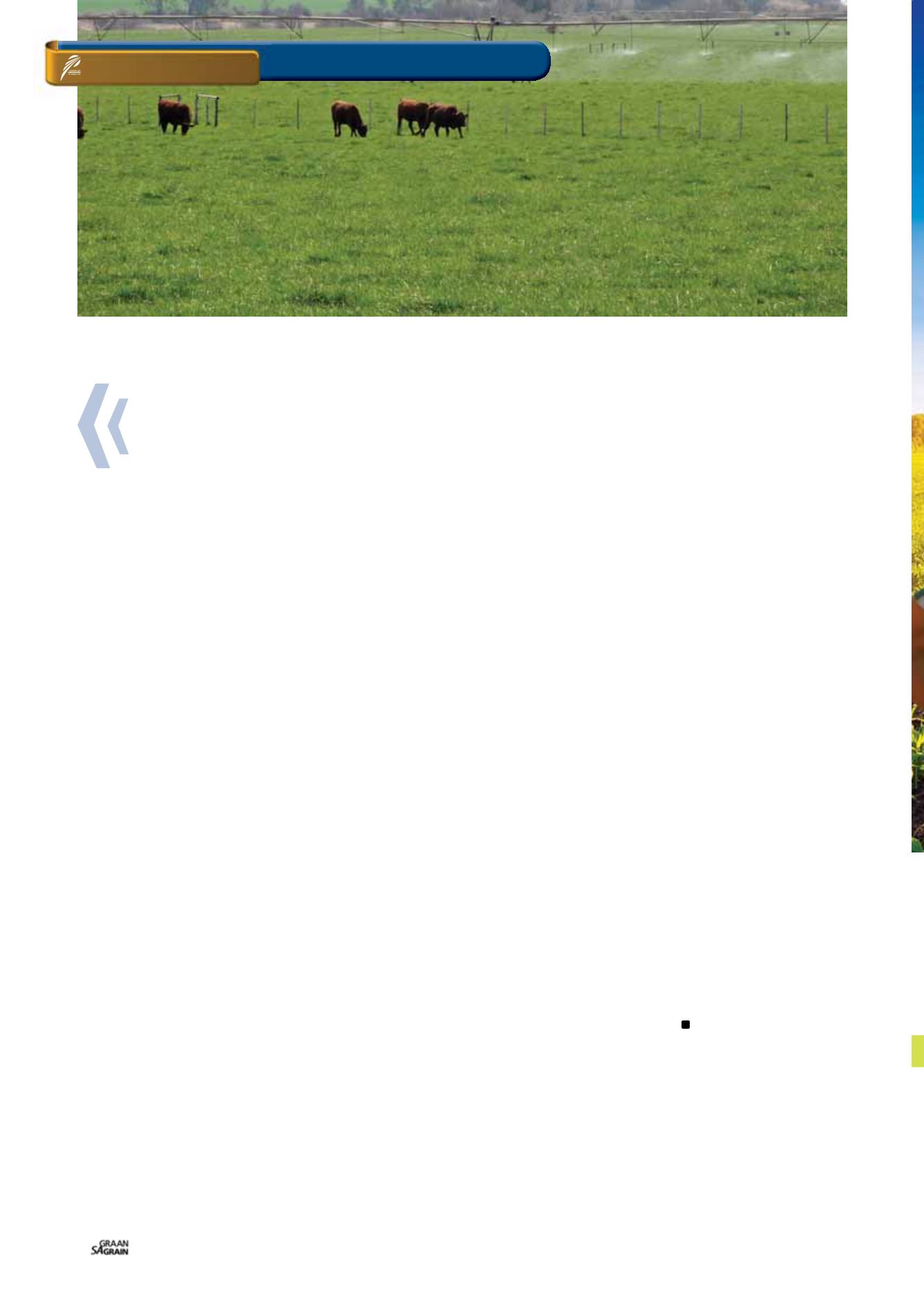

It is essential that the soil nutrient status especially phosphorus,
potassium, calcium and magnesium levels are rectified before plant-
ing. Good soil pH will ensure good soil nutrient availability. Fortu-
nately, when ryegrass is used as a cover crop on soil after a grain
crop, fertility is often not a problem.
When ryegrass is sown, these stands will primarily bind and protect
the soil followed by the utilisation by livestock should the need exist.
It is known that ryegrass, once sown can be grazed six to ten weeks
following planting.
Soil conservation and health benefits
Annual ryegrass has many cover crop benefits. When it is sown
with legumes and other grasses it is a good weed suppressor, due
to its ability to establish quickly which provides early season weed
control.
This species has an extensive root system that binds the soil ex-
tremely well. With a root system that establishes quickly in water-
logged, poor and even rocky soils it prevents a significant amount
of erosion.
In addition to the binding root system the dense shallow root sys-
tem improves water infiltration and enhances soil tilth. Ryegrass has
a rapid aboveground growth which helps supply a good source of
organic matter which can be good mulch that can support its weed
control and soil moisture preservation ability.
Since this species is a high N user, ryegrass can capture leftover N,
convert it to organic matter and reduce nitrate leaching; therefore
it is an excellent nutrient catch crop. Ryegrass can also be seen
as a nurse/companion crop, especially when perennial subtropical
species are planted in autumn for a longer grass ley crop period
of three to five years depending on the planned period of rest for
the grain crop field. The ryegrass then protects the seedlings of the
slower growing grasses or legumes from cold damage for example.
Management challenges
Often ryegrass grows very strongly at the time of seeding a sub-
sequent grain crop. It will be essential to eradicate the grass and it
can be done mechanically by mowing the material before seed set.
This can be done prior to spraying the ryegrass with a non-persistent
contact herbicide, although one can experience an incomplete kill
and/or resistance to glyphosate.
Fortunately, high temperatures damage any regrowth if the grain
crop is planted towards November when ryegrass growth generally
ceases in warmer climates.
To minimise N tie-up as the biomass decomposes, wait a few weeks
after incorporation before you seed a subsequent crop. Growing
ryegrass with a legume such as
Vicia
or
Trifolium
spp., would mini-
mise the N concern. Allowing the cover residue to decompose a bit,
the seedbed will be easier to manage.
Animal production aspects
Ryegrass can be used in many ways. Since it has a high moisture
content if cut, the best way to preserve it is through silage or hay-
lage. The most economical way to utilise it as a dual purpose cov-
er crop, is to graze it when there is sufficient growth, but it should
not be grazed intensively because regrowth is important to protect
the soil during the winter months.
Ryegrass can have a good grazing value with crude protein values of
between 20% - 24%. The dry matter digestibility of annual ryegrass,
however, is near 80% in the early season of growth particularly
in more temperate areas and as the season advances digestibility
decreases but may still be greater than 65% for much of the graz-
ing season.
The quality of forage is dependent on the factors that affect the
regrowth of grasses such as temperature, water and fertility. The
nutritive value of grasses decreases as the production season pro-
ceeds, depending on the number of harvests, the length of the
harvesting intervals, and the growth stage. This shows that as the
plant matures, it becomes more lignified and its nutritive value de-
creases thus making it less palatable.
Conclusion
It is noted that ryegrass is a very easy grass crop to grow and that
it can remove excess nutrients from the root zone and convert it
into soil organic matter which will eventually facilitate the storage of
nutrients for future use by successional crops.
Subsequently annual ryegrass cultivars have good value for live-
stock production systems producing highly palatable and digestible
forage. With good fertility these species provide rapid growth dur-
ing periods of cool temperatures and when sufficient soil moisture
is available, especially under irrigation systems. These attributes
make annual ryegrass an effective management tool for CA-based
crop rotation systems.
For more information, contact Dr Wayne Truter at
wayne.
truter@up.ac.za ,Prof Chris Dannhauser at
admin@GrassSA.co.za ,Dr Hendrik Smith at
hendrik.smith@grainsa.co.zaor Mr Gerrie
Trytsman at
gtrytsman@arc.agric.za .References
Dovrat, A. (1993).
Irrigated forage production
. Elsevier Science Publishers B.V.:
Amsterdam, The Netherlands.
Dickinson, EB, Hyam, GFS, Breytenbach, WAS, Metcalf, WD, Bassoon, WD,
Williams, F, Scheepers LJ, Plint, AP, Smith, HRH, Smith, PJ, Van Vuuren, PJ,
Viljoen, JH, Archibald, KP and Els, JN. (2004).
Kynoch Pasture handbook
. Kejafa
Knowledge Works: Maanhaarrand.
Fulkerson, WJ, Slack, K, Hennessy, DW and Hough, GM. (1998). Nutrients in
ryegrass (
Lolium
spp.), white clover (
Trifolium repens
) and kikuyu (
Pennisetum
clandestinum
) pastures in relation to season and stage of regrowth in a subtropical
environment.
Australian Journal of Experimental Agriculture
, 38:227 - 240.
Rhind, JM and Goodenough, DWC., 1973. Grass breeding information series 3.
The
Ryegrasses
. Department of Agricultural Technical Services. Natal region.
CONSERVATION AGRICULTURE
ON FARM LEVEL
Conservation agriculture
Maart 2016
78

















